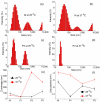Development of Polyurethane/Peptide-Based Carriers with Self-Healing Properties
- PMID: 37050311
- PMCID: PMC10096672
- DOI: 10.3390/polym15071697
Development of Polyurethane/Peptide-Based Carriers with Self-Healing Properties
Abstract
In situ-forming gels with self-assembling and self-healing properties are materials of high interest for various biomedical applications, especially for drug delivery systems and tissue regeneration. The main goal of this research was the development of an innovative gel carrier based on dynamic inter- and intramolecular interactions between amphiphilic polyurethane and peptide structures. The polyurethane architecture was adapted to achieve the desired amphiphilicity for self-assembly into an aqueous solution and to facilitate an array of connections with peptides through physical interactions, such as hydrophobic interactions, dipole-dipole, electrostatic, π-π stacking, or hydrogen bonds. The mechanism of the gelation process and the macromolecular conformation in water were evaluated with DLS, ATR-FTIR, and rheological measurements at room and body temperatures. The DLS measurements revealed a bimodal distribution of small (~30-40 nm) and large (~300-400 nm) hydrodynamic diameters of micelles/aggregates at 25 °C for all samples. The increase in the peptide content led to a monomodal distribution of the peaks at 37 °C (~25 nm for the sample with the highest content of peptide). The sol-gel transition occurs very quickly for all samples (within 20-30 s), but the equilibrium state of the gel structure is reached after 1 h in absence of peptide and required more time as the content of peptide increases. Moreover, this system presented self-healing properties, as was revealed by rheological measurements. In the presence of peptide, the structure recovery after each cycle of deformation is a time-dependent process, the recovery is complete after about 300 s. Thus, the addition of the peptide enhanced the polymer chain entanglement through intermolecular interactions, leading to the preparation of a well-defined gel carrier. Undoubtedly, this type of polyurethane/peptide-based carrier, displaying a sol-gel transition at a biologically relevant temperature and enhanced viscoelastic properties, is of great interest in the development of medical devices for minimally invasive procedures or precision medicine.
Keywords: amphiphilic polyurethane structure; polyurethane/peptide gel; self-assembly; self-healing carrier; viscoelastic behavior.
Conflict of interest statement
The authors declare no conflict of interest.
Figures












Similar articles
-
Thermosensitive hydrogel from oligopeptide-containing amphiphilic block copolymer: effect of peptide functional group on self-assembly and gelation behavior.Langmuir. 2013 Dec 23;29(51):15981-91. doi: 10.1021/la403331f. Epub 2013 Dec 13. Langmuir. 2013. PMID: 24328368
-
Erratum: Preparation of Poly(pentafluorophenyl acrylate) Functionalized SiO2 Beads for Protein Purification.J Vis Exp. 2019 Apr 30;(146). doi: 10.3791/6328. J Vis Exp. 2019. PMID: 31038480
-
A novel poloxamers/hyaluronic acid in situ forming hydrogel for drug delivery: rheological, mucoadhesive and in vitro release properties.Eur J Pharm Biopharm. 2008 Sep;70(1):199-206. doi: 10.1016/j.ejpb.2008.04.025. Epub 2008 May 9. Eur J Pharm Biopharm. 2008. PMID: 18644705
-
Weak and Strong Gels and the Emergence of the Amorphous Solid State.Gels. 2018 Feb 23;4(1):19. doi: 10.3390/gels4010019. Gels. 2018. PMID: 30674795 Free PMC article. Review.
-
Shape-Memory and Self-Healing Polymers Based on Dynamic Covalent Bonds and Dynamic Noncovalent Interactions: Synthesis, Mechanism, and Application.ACS Appl Bio Mater. 2021 Aug 16;4(8):5926-5943. doi: 10.1021/acsabm.1c00606. Epub 2021 Aug 3. ACS Appl Bio Mater. 2021. PMID: 35006922 Review.
Cited by
-
Diversity of Bioinspired Hydrogels: From Structure to Applications.Gels. 2023 May 2;9(5):376. doi: 10.3390/gels9050376. Gels. 2023. PMID: 37232968 Free PMC article. Review.
-
Thermosensitive Polyurethane-Based Hydrogels as Potential Vehicles for Meloxicam Delivery.Pharmaceuticals (Basel). 2023 Oct 24;16(11):1510. doi: 10.3390/ph16111510. Pharmaceuticals (Basel). 2023. PMID: 38004376 Free PMC article.
-
Rheology as a Tool for Fine-Tuning the Properties of Printable Bioinspired Gels.Molecules. 2023 Mar 19;28(6):2766. doi: 10.3390/molecules28062766. Molecules. 2023. PMID: 36985738 Free PMC article. Review.
-
Self-Healing of Pluronic® F127 Hydrogels in the Presence of Various Polysaccharides.Gels. 2023 Sep 5;9(9):719. doi: 10.3390/gels9090719. Gels. 2023. PMID: 37754400 Free PMC article.
-
Targeting Injectable Hydrogels: The Role of Diphenylalanine Peptide Derivative in the Gelation Dynamics of Pluronic® F127.Polymers (Basel). 2025 Mar 29;17(7):930. doi: 10.3390/polym17070930. Polymers (Basel). 2025. PMID: 40219321 Free PMC article.
References
LinkOut - more resources
Full Text Sources
Research Materials
Miscellaneous

